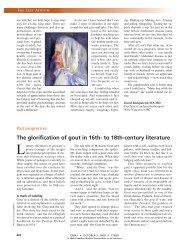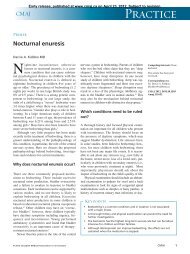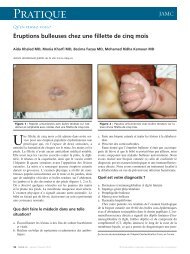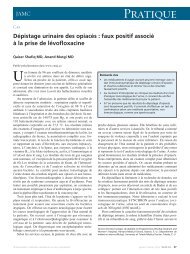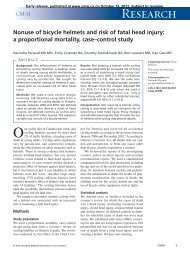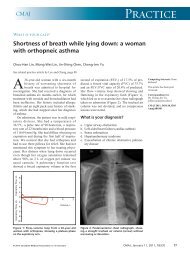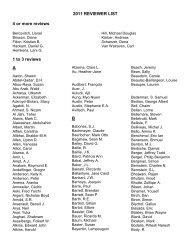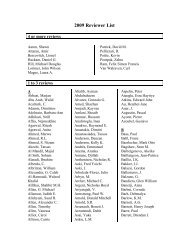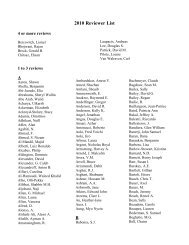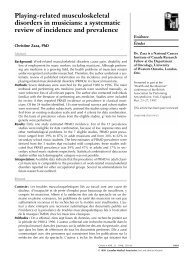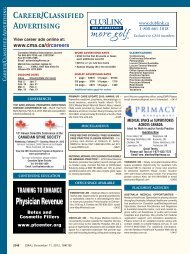Tips for teachers of evidence-based medicine: 1. Relative risk ...
Tips for teachers of evidence-based medicine: 1. Relative risk ...
Tips for teachers of evidence-based medicine: 1. Relative risk ...
You also want an ePaper? Increase the reach of your titles
YUMPU automatically turns print PDFs into web optimized ePapers that Google loves.
<strong>Tips</strong> <strong>for</strong> <strong>teachers</strong> <strong>of</strong> <strong>evidence</strong>-<strong>based</strong> <strong>medicine</strong><br />
from their own experience or expectations, what the event<br />
rates would be in the control and treatment groups and<br />
also to guess the <strong>risk</strong> difference <strong>for</strong> each treatment and<br />
how many patients would have to be treated to prevent<br />
one outcome. For example, in 60-year-olds with mild hypertension<br />
(e.g., blood pressure 150/95 mm Hg), what<br />
event rate would be expected in the control group and the<br />
treatment group and what <strong>risk</strong> difference and NNT would<br />
be expected if the treatment group received diuretics over<br />
5 years to prevent stroke?<br />
Remember that the learners have not yet been told how<br />
to calculate NNT, nor have they been given a <strong>for</strong>mal definition<br />
<strong>of</strong> it. As a result, they will usually struggle and complain<br />
that they do not know how to calculate the numbers.<br />
This is to be expected, and they should be encouraged to<br />
guess or estimate (rather than calculate) each number.<br />
After the learners have struggled with this exercise <strong>for</strong> a<br />
few minutes, construct Table 3 and, without filling in any<br />
<strong>of</strong> the values yourself, ask them to independently write<br />
down their own estimates and then ask some (or all) <strong>of</strong><br />
them to write these estimates on the board. The learners’<br />
guesses may be very strange — the <strong>risk</strong> differences may be<br />
huge and there will be no mathematical relationship between<br />
the <strong>risk</strong> difference and the NNT because the learners<br />
will have guessed rather than calculated the numbers.<br />
Put no restrictions on these guesses – if they are wildly<br />
wrong then the impact <strong>of</strong> the exercise is only enhanced.<br />
After the learners have written their various estimates on<br />
the board, you can add the event rates <strong>for</strong> control and intervention<br />
groups <strong>for</strong> each condition, taken from published<br />
trials 13-15 (Table 3). The final column, labelled “NNT” will<br />
still be blank.<br />
Using these event rates, you can explain how to calculate<br />
NNT <strong>for</strong> those who do not already know. Learners not familiar<br />
with NNT will almost certainly stumble over the<br />
calculations. Confusion is <strong>of</strong>ten caused by the possibility <strong>of</strong><br />
presenting <strong>risk</strong> difference as a proportion (e.g., 0.25) or as a<br />
percentage (e.g., 25%). You can help them with this potential<br />
pitfall by emphasizing that if they have expressed <strong>risk</strong><br />
difference as a percentage, then they calculate NNT by dividing<br />
the <strong>risk</strong> difference into 100. Alternatively, if they<br />
have used a proportion to express the <strong>risk</strong> difference, then<br />
they calculate NNT by dividing the <strong>risk</strong> difference into <strong>1.</strong><br />
In Table 3, we have expressed all the rates and <strong>risk</strong> differences<br />
as percentages.<br />
An alternative to simply providing the <strong>for</strong>mula <strong>for</strong> NNT<br />
is to use the following approach, in which learners derive<br />
the <strong>for</strong>mula <strong>for</strong> themselves. Ask the following question: “If<br />
a disease has a mortality rate <strong>of</strong> 100% without treatment,<br />
and therapy reduces that mortality rate to 50%, how many<br />
people would you need to treat to prevent 1 death?” (Answer:<br />
2.) Continue with more examples, until the learners<br />
work out <strong>for</strong> themselves that NNT = 1/<strong>risk</strong> difference expressed<br />
as a proportion or 100/<strong>risk</strong> difference expressed as<br />
a percentage.<br />
You will now have completed the final column <strong>of</strong> Table<br />
3, and you will probably find that the learners are interested<br />
in the actual numbers <strong>for</strong> treatments they may be <strong>of</strong>fering<br />
on a daily basis. Most physicians overestimate the<br />
effects <strong>of</strong> their interventions, particularly in the treatment<br />
<strong>of</strong> hypertension.<br />
This exercise gives learners an opportunity to discuss<br />
how they would decide what is a reasonable NNT and introduces<br />
them to the concept <strong>of</strong> a threshold NNT, the<br />
maximum NNT that they and their patients would accept<br />
as justifying the <strong>risk</strong>s and costs <strong>of</strong> treatment. Determinants<br />
<strong>of</strong> the threshold NNT include the patient’s values<br />
and preferences, the severity <strong>of</strong> the outcome prevented,<br />
and the costs and side effects <strong>of</strong> the intervention. The<br />
learners will discover there is no simple answer to the<br />
question <strong>of</strong> when an NNT is sufficiently low to warrant<br />
treatment.<br />
Extension <strong>for</strong> more advanced learners<br />
For highly motivated learners, or if you have the luxury<br />
<strong>of</strong> running a workshop rather than just a 1-hour session,<br />
you can extend the discussion by looking at the marginal<br />
gain <strong>of</strong> using tissue plasminogen activator (t-PA) instead <strong>of</strong><br />
streptokinase in the treatment <strong>of</strong> acute myocardial infarction.<br />
The NNT <strong>for</strong> the marginal benefit <strong>of</strong> t-PA over<br />
streptokinase is about 100 to prevent 1 death over 30<br />
days. 16 Ask the learners if they think that number is clinically<br />
significant and what their own threshold NNT might<br />
Table 3: Estimates derived from published trials, to be presented to learners <strong>for</strong> comparison with their<br />
independent estimates (tip 3)<br />
Event rate, %<br />
Population, intervention and outcome <strong>of</strong> interest Control group Treatment group Risk difference, % NNT<br />
60-year-old patients with hypertension, diuretics, 2.9 <strong>1.</strong>9 <strong>1.</strong>0 100<br />
stroke over 5 years 13<br />
60-year-old patients 1 month after MI,<br />
9.8 7.3 2.5 40<br />
β-blockers, death over 2 years 14<br />
60-year-old patients with acute MI, streptokinase,<br />
death over 5 weeks 15 12.0 9.2 2.8 36<br />
Note: MI = myocardial infarction, NNT = number needed to treat.<br />
CMAJ • AUG. 17, 2004; 171 (4)<br />
Online-5



